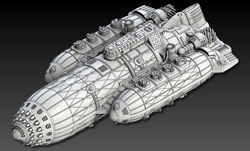
|
| Quorahi
|
|
Tribal Leaders
|
- Kiast
- Foothold
- Cainstead
- Volstrad
- Gand Colonies
|
|
722 BBY
|
|
356 BBY
|
|
Vatali Empire
|
The Quorahi are a group of nomadic tribes and city-states situated on the planet of Kiast, serving as an underclass to the Sephi dominated Vatali Empire. A disparate and largely individualistic people of various species, cultures, and levels of technology, they existed on the surface of Kiast in either mobile fleets, floating refinery cities or fortified settlements shielded against the toxic clouds. Frequent conflicts with the nobility led to discontent among their number, especially during late 37 ABY, which drew Clan Odan-Urr into the uprising.
History
Foundation
The Quorahi themselves have no specific beginning or announced foundation, but their presence has been felt since before even the establishment of the Vatali Empire. Several groups date their origins back to the Gand settlers who established mining colonies on the planet in 2000 BBY. Thriving in the Type I atmosphere of the planet, the Gand never established any permanent structures on the world, and even the colonies themselves were continually dismantled and re-established wherever there was a suitable source of ore. Nevertheless, the Gand remained on the surface and made their living ferrying materials to potential buyers. This remained the case until just over a thousand years later in 900 BBY, with the coming of the Sephi Dominion.
The Dominion claimed the Kiast System for themselves, and constructed cities on the upper reaches of mountains or via skyhooks in order to colonize the world. The Gand were largely left to their own devices, without contact or interference from the Sephi rulers so long as they accepted that the Dominion held rule over the planet. During this period of relative peace, the Sephi adapted to the world's environment and constructed new technological developments to survive above the poison clouds dominating the surface. This gave rise to floating platforms, airships and mining facilities, with a number of these cities serving as a self-sustaining refinery for ores found by miners.
After the passing of Kiast's original ruler, Ranorm Anasaye, a number of reforms were made by the newly crowned Lord Tanisad Anasaye. These were pushed with the intent of freeing Kiast from the influence of the Sephi homeworld of Thustra, and led to two centuries of gradual change throughout the system. As the planet's navy was strengthened and infrastructure enforced, a number of deals were made with the surface-dwelling Gand tribes, allowing settlers to establish themselves on the surface or regions besides those already claimed by the Sephi. The inhabitable regions were quickly claimed by a variety of species, ranging from Humans to Kyuzo, Melitto and Teedo, along with a multitude of Near-Human groups. Any area which could be rendered inhabitable was quickly claimed and, by 537 BBY, the new species vastly outnumbered the Sephi populace. A series of bylaws were quickly passed in response to this, making all within the Kiast system subjects to a single Vatali King.
The push to gain independence intensified during the reign of King Vatal, who was eventually able to successfully initiate a coup against the Sephi rulers and claim the system for his dynasty. The colonists served as both a labour force to be exploited and soldiers in this War for Independence, but it soon became clear that they were to have no part in whatever golden age might follow.
The Quorahi Wars
Having renamed himself Emperor, Vatal's reign led to an exponential growth in the newly formed Vatali Empire's wealth. The nobility, backed by a vast fleet of warships and hoarding material wealth within their fortified cities, were able to treat the colonists as little more than slaves due to their position of strength. By the time of Vatal's death, his subjects had been forced to continually build monuments to his glory and their movements restricted to vast industrial cities that the colonists were little more than prisoners within. It was during this era that the colonists came to be labeled as the Quorahi, or "The Folk" in more common Sephi, which served as a blanket term of the varied species and factions under their rule. As discontent rose, as did the growing desire to be rid of the tyrants who had come to dominate their world. With entire generations having grown up under their rule, the oppression of the lower classes led to several outbreaks of violence and rioting. Efforts to quell these actions did little to dissuade the disgruntled populace, and following Vatal's death, the cities began communicating with plans for an outright rebellion against the nobility.
Due to their low standing, the level of technology and communication that each city was privy to varied considerably from one location to the next. While certain Quorahi groups were given access to equipment only marginally inferior to those of the Sephi, others relied upon equipment that had not been updated or improved since the planet had been first colonized. This made the act of resistance notably difficult, as did the authority wielded by the nobility. Empress Darsayi Anasaye lacked the experience or authority to cow the nobles into following her rule, allowing the noble houses to act without risk of repercussions. This allowed the nobles to treat the Quorahi however they desired, enforcing laws that saw mass executions for speaking out against any Sephi or their military supporters.

When war finally broke out in 198 BBY, it was in a full-scale rebellion that deprived the Vatali of much-needed resources and access to facilities vital to their economic standing. Utilising these positions to their benefit, the Quorahi fought a series of bitter sieges and skirmishes, seeking to deny the Sephi ground or even easy access into the factory cities that they had transformed into bastions. The conflict lasted a full two years before the rebellion was quelled, but it brought with it a number of considerable improvements for the Quorahi. New laws were put forward to improve their living conditions and a number of decrees were initiated which protected them from the worst of the nobles' excesses. This saw a noted change for the better among their kind, but it was only a temporary reprieve. The Sephi used their long lives to their own benefit, slowly chipping away at those very laws over the course of several generations, and gradually stripping the people of their rights via disguised treaties and reforms. In just under a century, the Quorahi were forced back to being an abused underclass of workers. Some resistance existed against the nobles, but it lacked the same unified backing or strength of arms which had benefitted the previous uprising.
Salvation would eventually come from an unexpected source. The infighting and competition among elements of the nobility eventually came to work against them, as Taselm Anasaye, seeking to claim the throne from his mother and outplay his brothers. Allying himself with one of the more active Quorahi tribes rebelling against the nobility's rule, Taselm earned their loyalty through his actions in support of their cause and a willingness to cripple the Empire if driven to such lengths. Rather than leading from above as nobles so often did, he led from the front. This attitude allowed him to gradually build support from various Quorahi groups until three years later, in 77 BBY, he was able to initiate a second full-scale rebellion against the nobility. Having learned hard lessons in the past war and adapted their tactics, the Quorahi were able to infiltrate and claim many of the nobles' cities in brief engagements. Using their floating refinery cities as mobile bastions and surface-based settlements as safe harbours for their airships, they were able to deny the advantages that the larger Vatali fleet offered in opeb attles. Careful but focused fighting in key areas of the planet allowed the Quorahi to steadily ground, until an assault on the Voraskel Palace and the death of Empress Darsayi brought the three-year war to its end.
With the backing of the Quorahi, Taslem claimed the Vatali throne for himself, and initiated a series of massive reforms. Redefining both the class system and recognizing the Quorahi as workers employed by the Empire rather than indentured serfs, Taslem pushed for greater equality among the masses. By the end of his efforts, the political power of the nobles had been severely diminished despite retaining their wealth, and the previous species superiority that the Sephi benefitted from was all but erased. The years of Taslem's reign proved to be almost as turbulent as his rebellion, but by through political maneuvering and careful actions his loyalists were able to avoid the outbreak of a new war. Even as fears of another Quorahi war briefly arose as the Empire's military was scaled back in favour of improved funding for scientific endeavors and trade, Taslem was able to avoid a conflict while improving the balance of power between both groups. This allowed the Quorahi to begin openly expanding and developing their tribal states, building upon what had existed before and continuing to work for the Vatali Empire as laborers, but with the freedom to govern and control their own settlements with little outside interference.
Age of Reason
Although aged at the time he was accepted onto the throne, Taslem was able to lead the Empire into a new golden age. With the nobles largely content thanks to retaining their personal fortunes and the Quorahi given the freedom that they had long yearned for, tensions between the two groups gradually subsided. Each focused on new territories of exploration and development, with these distractions serving to avoid reigniting possible conflicts. The Quorahi were able to thrive in this era, expanding and spreading out across the planet. Scavenging sites across its surface and working to capitalize on what this new era offered, the tribes sought to establish themselves as larger nations. While some established themselves as nomadic airship flotillas, others continued to build ports and new settlements wherever they could be supported. This led to a number of clashes between rival tribes, but such wars were mere skirmishes compared with the battles of the past years.
 Freed from the authority of the Vatali, Quorahi city-states evolved and diverted dramatically from their original designs.
Freed from the authority of the Vatali, Quorahi city-states evolved and diverted dramatically from their original designs. After a reign of seventy years, Emperor Taslem passed away, leaving his throne empty for others to take. Unlike past Emperors, his death was mourned not only by then nobility but also much of the Quorahi for what he had given them. Yet with that mourning came concerns as to what would follow over the next decades. Taslem had been a major driving force behind the equality which had benefitted the tribes, often in spite of the wishes of the wider nobility. With his passing and no obvious individual to take his place as a peacemaker, some feared that they would see a return to the tyranny which had followed in the wake of the first rebellion. Yet events took an abrupt turn. Essadan Anasaye, Taslem's direct successor, was murdered only a few brief months into his reign. The assassin was his brother, Vauzem, a power-hungry individual who had secretly been plotting to claim the throne for years before Taslem's death. Rechristening it into the Vatali Empire the Vauzem Dominion, Vauzem sought a return to the totalitarian ways of his ancestors.
Yet Vauzem's reign proved to be almost as short as Essadan's tenure, as he soon faced a massed rebellion from every faction on the planet. Recognizing the tyrant for what he was, the noble houses backed Taslem's sister Kaltani Anasaye and declared her Empress. The full Vatali military soon backed Kaltani's claim, leading to a war between the supporters of either side. The battle turned when the Quorahi, in a rare move of total unity, arrived to turn the tide in Kaltani's favour. Floating factory cities upgraded with weapons, fleets of ramshackle airships and nomad tribes committed themselves to the fight, driving Vauzem into retreat and inflicting heavy casualties among his forces. Much of the Palace was lost in the fighting and there was heavy damage inflicted upon each side and, with Vauzem in retreat, every group soon turned to recovery and reconstruction. The bloody dawn to Kaltani's reign was nevertheless a start to an otherwise peaceful first few decades. Hidden from most star maps and protected by the Palioxis cloud, the Kiast system was spared the ravages of the galaxy's greater wars. Even with the threat of the Dominon's return, times were relatively peaceful. This changed in 35 ABY with the coming of Clan Odan-Urr and the survivors of New Tython. In a fleet of tattered warships, the group sought sanctuary after the Dark Jedi Brotherhood had glassed their homeworld, murdering most of its populace in a petty act of xenophobia.
Areas on the planets of Solyiat, Daleem and the moon of Kaerls were given over to House Hoth, House Satele Shan and the Okami respectively. While the decision proved to be a controversial one among the more hardline nobles, the Empress nevertheless stood by her decision. Much of this did not matter to the Quorahi tribes, who continued to live on Kiast's surface as they had done for centuries. Contact with the new outsiders was limited and few among the New Tython survivors wished to settle among the tribes, permitting them to go about their daily business with little in the way of interruptions. The Quorahi themselves would hear of distant events, from the war the Jedi were raging against the Sith who had betrayed them and battles waged between vast warships, but they played no active part. The closest that they came to a true conflict was with the poisoning of Empress Kaltani in an effort to frame the Odanites as initiating a grab for power against the system's rightful rulers. This was created by an alliance between Beldroth, the ruling Lord of the Dominion, and Inquisitor Ishanta of the Brotherhood; a fact which only became clear to a select few within the Empire at a much later date.
The Dominion initiated a series of massive attacks in a bid to claim power, many of which served as false flag operations to distract the Vatali from their invasion and frame Odan-Urr's troops for atrocities. Many of these were focused upon the Vatali cities, but a number also bled over into Quorahi settlements. Odan-Urr's forces were able to foil several efforts key to the Dominion's subterfuge, deflecting several false flag attacks and abductions. Nevertheless, a number of Quorahi factions were shaken by this turn of events. As the Dominon's swift victory turned into a bitter stalemate between the two forces, feelings of resentment among certain tribes would become a key factor in battles to come.
United Quorahi Uprising
As the Vatali-Dominion war was dragged on into becoming a stalemate, the Dominion began to view the Quorahi as a possible asset in their favour. Many agents began to sow feelings of discontent and resentment toward the Sephi, rekindling long-dead rivalries and creating some anew. Many were able to build upon the damage that Dominion itself had inflicted, while others worked to inspire hatred through new atrocities. The settlement of Foothold was among these, as a pair of cybernetically augmented Gundarks were used to commit a string of murders, inspiring the citizens to believe that the nobles had loosed a monster upon their town. This was only halted with the intervention of Essik Lyccane, but it proved to be a motivating factor among the more disgruntled tribesmen. It was by no means isolated, and other acts only increased the tension among other tribes.
Matters were only made substantially worse once Kaltani recovered from her attempted poisoning, and Alethia Archenksova stepped down from her forced role as Regent. As the Dominion and - with some manipulation by Archenksova as part of a secret agreement to secure peace with the Brotherhood - the Collective were blamed for the attacks, the Empire declared open war upon both groups. The Quorahi were largely ignored in the following months, allowed to continue their lives and rebuild, but the scars from the Dominion's efforts did not heal. As the war dragged on and skirmishes were waged by both sides, discontent continued to rise among the lower classes. Talks even began among some of the tribe leaders.
Even as the Dominion was decapitated in a decisive strike against their leadership, rendering them incapable of coordinating their fleets, their efforts with the Quorahi steadily snowballed. Slowly but surely discussions began among the tribe leaders, with each pushing for a unification effort and a desire to break from Vatali dominance. By the time of late 37 ABY, discussions had begun among multiple tribe leaders, with many joining for a secret meeting in the town of Foothold. Not all were in agreement on any singular matter, or even the desires of certain extreme groups. While many believed that greater self-determination was needed in order to survive, others felt that an open declaration of independence backed by veiled threats was suicide. Others sought to settle generations-old scores, while the more pragmatic besides them viewed this as an opportunity to enhance their own power. Nevertheless, by the meeting's end, the groups came upon an agreement. Declaring themselves to be the United Quorahi, a series of loose terms were created to balance power among the various groups:
Technological recoveries and salvage is to be shared equally among townships, dependant of size and necessity.
Conflicts which require blood are to be settled by duels between chosen champions, either in-person or by airship rather than full-scale wars.
Militia forces will stand as they are, but a yearly tithe will see airships and warriors leased to a broader grand army.
Resources are to be split equally between city-states, and nomad fleets will no longer be barred from one another’s territories.
City-states will be permitted to continue governorship, but wider judicial and planetary decisions will become the jurisdiction of a unifying council.
Although some representatives at the meeting were apprehensive of some definitions and how such words might be twisted to favour some Quorahi over others, each eventually agreed to support the initial implementation of the terms. Even those uncertain of the future wished to be a part of a larger federation which might benefit their people, and the greater opportunities it might offer. Yet unbeknownst to the Quorahi, the meeting had been observed and recorded by members of Odan-Urr led by Essik Lyccane, who soon relayed warning of what this might represent to Empress Kaltani.
Major Cities & Tribes
The Quorahi are divided among various settlements of different forms across Kiast's surface. Some dwell on mobile foundry cities first established by the Vatali thousands of years ago, others operate in nomadic fleets of airships, while a few towns exist on the surface, either in permanent or temporary settlements. Those outlined below are several of the more noteworthy villages established by the tribes.
Foothold is typical of the lowermost settlements on Kiast. Nestled in the uppermost peaks of the mountain range, it hangs just above the rolling clouds of toxic gasses. Guarded against the poisonous air by airlock sealed buildings and a surrounding atmospheric shield, the settlement serves as both a major trading post and airship dock among Kiast's large northern mountain ranges. As is to be expected of Quorahi designs, the entire settlement has been constructed with practicality valued far above any desire for an aesthetically pleasing design. Many areas have been built from repurposed materials or contrasting elements, with the primary buildings forged from ferrocrete while the larger docking towers have been constructed from starship hulls, some of which still display their former iconography. Much of this is held in place via a combination of support struts, industrial anchors driven into the mountain, and repulsorlift engines. Adjoining networks of bridges and walkway platforms link the various areas together, with some designed to rise and fall in order to permit the passage of airships into the settlement's primary hangers.
The name Foothold itself stems from an urban legend that the site was where the first non-Gand colonists founded their initial encampment before branching out into new areas. This has been heavily contested by other Quorahi groups over the years, but the settlement's name remains unchanged.
Cainstead
Another of the static colonies established by the Quorahi after they were granted their freedom, Cainstead was established in a crater-like peak of a mountain. While the original buildings had established themselves in a ring about its top, their constant mining has worn away at the foundations, leaving them situated in an artificial crater. This was entirely intentional, as such a position granted the town a far more defensible position against outsiders and made transporting ore to the surface an infinitely easier task. The success following the discovery of multiple metal-rich veins and the presence of advanced ore processing plants gave the town good economic standing. This left the town with a better infrastructure than their contemporaries, with multiple environmental domes, military bunkers, and prefabricated buildings alongside the usual mixture of repurposed starships.
The township recently suffered a major setback following the collapse of multiple mine shafts. This forced the inhabitants to divert funding into reclaiming their primary resource and repairing damage from the freak earthquake, putting several plans on hold. While there was no loss of life, some have accused Clan Odan-Urr of covertly plotting the attack. Thus far, no evidence has emerged to back this claim.
Volstrad
Volstrad, also known as Winterborn in Basic, is one of the nomadic corsair cities traversing the northern regions of the planet. The city had been claimed by a pirate fleet during the Second Quorahi Uprising and converted into a mobile port for their ships during the war. Despite multiple efforts by the Vatali to retake the city through law, it remains in the ownership of the pirates and its Overlord. As it was overwhelmed by a night raid, the city was captured with little damage and bears no obvious scars of war. The damage inflicted to it instead stemmed from the gradual alterations made over the following years, as iron plating and drydocks were bolted to the larger mainframe. This leaves the city with a bizarre mishmash of black armoured facilities built over baroque and graceful architecture.
The city claims to be openly neutral in all conflicts, favouring instead random raids of various settlements. In truth, the corsairs more often than not lend their services out as mercenaries to the highest bidder.
Gand Settlements
The settlements of the Gand are as varied as the greater Quorahi, but they are typically listed under a single designation. This is largely thanks to limited contact with settlements dwelling so far beneath the toxic clouds which dominate the surface, as the Gand have typically been left to govern themselves with limited interruption. What little has been told of their settlements indicates a semi-nomadic state of life. A number of tribes live out of prefabricated settlements which are briefly established upon finding a wealthy resource to strip only to be quickly moved once nothing remains. Some are repurposed from existing assets, while others are purchased wholesale from independent traders. In the wake of the Galactic Empire's surrender, surplus military-grade equipment and shelters have become commonplace among some groups. Others are noted to even use the hulls of airships lost beneath the clouds as housing, a point which has led to conflicts in past meetings. A small handful of Gand settlements are thought to have been permanently entrenched on key locations of the northern hemisphere. The exact reason why is as of yet unknown, but theories range from requiring their use as static communications bases to more expansive fortifications.
Culture
 Although tribal, the Quorahi are technologically superior to many other galactic species.
Although tribal, the Quorahi are technologically superior to many other galactic species. The Quorahi are fragmented due to their tribal nature, with no wider government to unite them. Many groups have spent centuries more concerned with their own welfare than that of the wider galaxy, while others are open traders. Due to the melting pot of species, objectives, terrain, and resources that varies heavily from one tribe to the next, no two are entirely alike. Yet even with their more scattered nature, there are a number of defining aspects that are shared among the various tribes. The most notable among these is an attitude of fierce independence and self-reliance, born of having to make use of any resources that they can lay their hands on. As much of Quorahi technology has been scavenged from Kiast - and battles between tribes over new findings are hardly uncommon - they can rarely afford to tolerate those that do not pull their weight and need to actively ensure that they live to see tomorrow. This has evolved in several tribes to form a more collectivist mentality of every person doing their part to help with a greater whole. Others have adapted this attitude to form a more competitive environment of each sub-group seeking to benefit themselves over their rivals.
A notably anti-authoritarian attitude is prevalent among most tribes, likely stemming from their origins as slaves to the Vatali nobility. This has been tempered considerably thanks to generations of reforms and pushes to promote equality among Kiast's groups, but it has flared up on a number of occasions due to lingering distrust. The matter has hardly been helped by the likes of the Vatali-Dominion conflicts or other instances where the Quorahi have either been required to shed blood or were caught in the crossfire. Nevertheless, it is not a domineering attitude, as service to the tribe typically wins out over any contempt for the nobility and a substantial number of tribesmen do understand that their lives would be infinitely more difficult without the nobles. This has resulted in a sense of camaraderie between the various tribes, no matter their history, home or service to others.
The eclectic mix of scavenged technology and resources, along with their tribal mentality, has led to oddities existing within the Quorahi way of life. While it has been admitted repeatedly that their technological level among various tribes is notably higher than a multitude of other species, it has manifested in a number of unusual ways. The prevalence of airships held aloft by gasbags has caused many to overlook the more advanced repulsorlift drives which assist them, while other devices have been adapted into seemingly more rustic variations which can hide their more advanced nature. This is not universally true, but it has been suspected that the Quorahi's heritage has encouraged this odd development of their technologies.
Industry
The industries of the Quorahi are heavily reliant upon three factors above all else: Their foundry cities, the Vatali, and sources of technology abandoned on Kiast's surface. Lacking the larger national or planetary governing structures which benefit more conventional nations, and the limited access to conventional resources of farming land, ore deposits and the like, this has left the Quorahi to develop in an unusual manner. Most tribes typically evolve and adapt about whatever resource they found to be most beneficial to their people, or particular assets which can be used to build towards establishing greater influence. A large number of tribes retained the foundry cities which had once served as factory-prisons for this reason, converting them into nomadic fortresses and skyborne ports as much as resource hubs. Those situated on the ground are typically built upon higher peaks, either serving as static ports in largely desolate regions or mining communities wherever they can be found. The main exception to these are the nomadic fleets which live purely on airships, earning their living either as traders or corsairs. These groups typically form long-standing agreements with other tribes to repair or construct new airships, typically for mutual benefit.
 Designs such as observation ships were among the few rarely altered under Quorahi ownership.
Designs such as observation ships were among the few rarely altered under Quorahi ownership. The Quorahi themselves rely heavily on the Vatali for a substantial portion of what they require to survive, from key resources needed to keep their machinery running to contact off-world. Even with their emphasis upon self-reliance, it has always been an essential part of their way of life. When not trading with the nobility for beneficial resources, they will maintain contact with one another or, in a few cases, attempt to violently claim what is needed. As no single tribe is the same, the governing laws, attitudes, and taboos vary heavily between each cultural group. This often crosses over into the equally important industry of salvage efforts, as major conflicts have been fought over particular finds. As both require the ability to cover vast regions and travel at high speeds, quality of airship construction and ownership of multiple vessels is a major part of how successful any tribe might be, in its capacity to succeed in expanding its influence.
The effect that trade, scavenging, and refining materials have had upon the tribes is notable in a "make do" attitude in most things. Although not averse to aesthetic beauty, pragmatism and the need to survive typically wins out ahead of all other aspects of life. Starved of resources and with the abrupt expansion of the tribes into new regions, many Quorahi groups found themselves utilising any resources on hand to sustain themselves. As such, the ability to reverse engineer technology and repurposing them has become a major boon to a number of groups. The scale of such efforts can range from converting aging starship hulls into new housing environments to utilising engine coolant systems as a component in hydroponics farms.
Trivia
The icon used for the Quorahi was created by Agate Gua’lara.